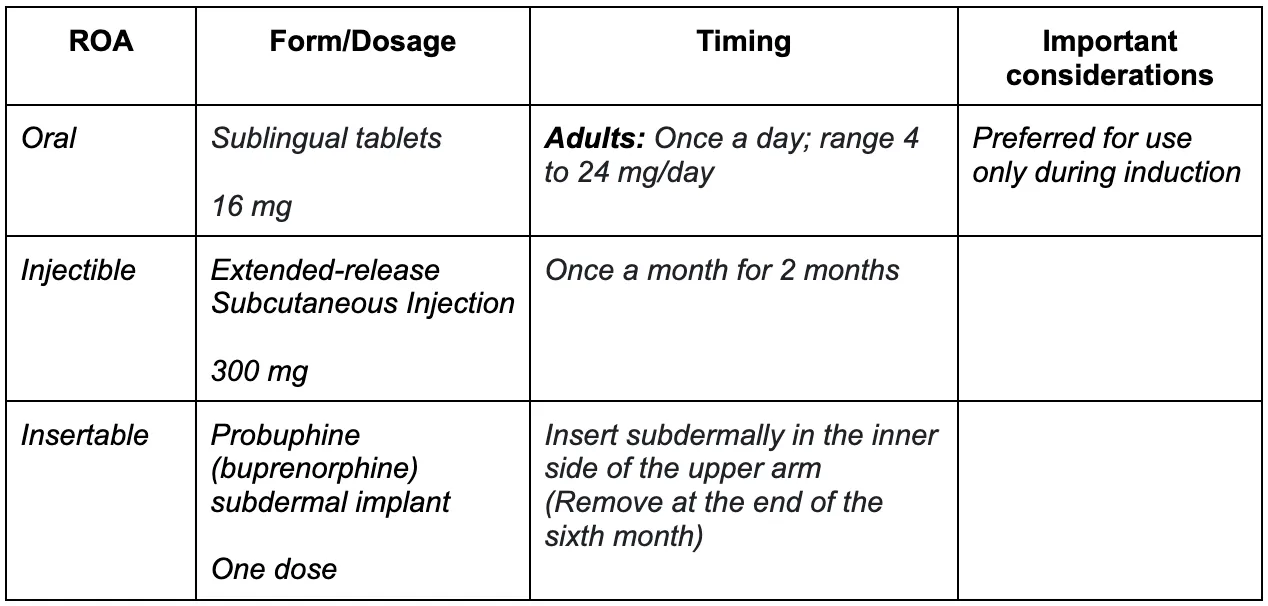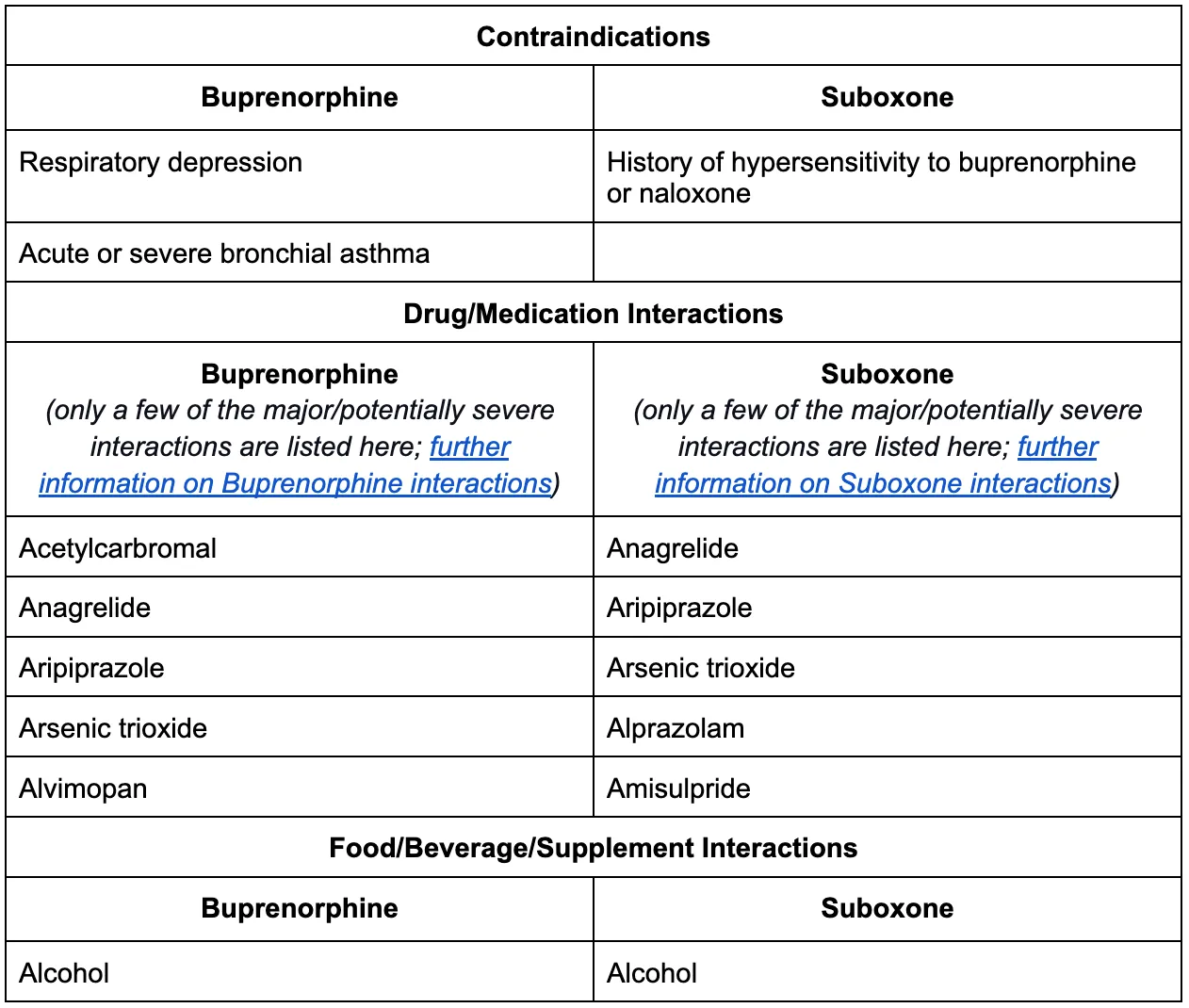Your session is about to expire
Buprenorphine vs Suboxone
Introduction
Approximately three million individuals in the United States and 16 million globally have experienced or are now suffering from opioid dependence. Buprenorphine and Suboxone are common drugs prescribed to opioid addicts to treat opioid dependence. Buprenorphine is an opioid partial agonist drug that induces respiratory depression or euphoria, which helps minimize the effects of opioid dependency, like cravings or other withdrawal symptoms.
Apart from treating individuals with opioid dependence, it is also often prescribed for treating pain. On the other hand, Suboxone is a drug manufactured primarily to treat opioid dependence. It helps manage withdrawal symptoms when an opioid addict stops or reduces opioid intake.[1]
About Buprenorphine vs. Suboxone
What is Buprenorphine?
Buprenorphine was first approved by the FDA (Food and Drug Administration) in October 2002. It was introduced in the United States under the (DATA 2000) Drug Addiction Treatment Act. This act allows Buprenorphine to be administered to individuals with opioid dependence in an outpatient setting by any licensed medical health practitioner (physician, physician assistant, or nurse). Buprenorphine is a popular drug used to treat opioid dependence because of the limited clinical barriers linked with prescribing medication for opioid dependence. Buprenorphine influences how an individual may feel pain by altering the way our nerves signal pain from between the body and the brain. By replacing Buprenorphine with other opioids, doctors can help reduce the several negative effects of withdrawal and minimize the likelihood of harm linked with drug dependence.[2][3]
What conditions is Buprenorphine approved to treat?
Some conditions that Buprenorphine is approved to treat, include[4]:
- Opioid dependence
- Acute pain
- Chronic pain
How does Buprenorphine work for opioid dependence?
Buprenorphine serves as a partial opioid agonist. This drug has a profound affinity for the µ-opioid receptor and works by targeting the κ-receptor. The µ-receptor's strong affinity for and restricted intrinsic activity block the reinforcing effects of exogenous opioids. Despite being classified as a partial opioid agonist, buprenorphine's strong binding properties and consistent dissociation rate result in low physical dependence and minimal clinical effect. Buprenorphine reduces the likelihood of overdose and has minimal toxicity, even at excessive doses. Buprenorphine has the potential to block the effects of exogenous opioids, which aids in reducing illicit opioid usage. One major advantage of using buprenorphine to treat opioid addiction is that it does not provide the 'high' or 'rush' that addicts desire.[5]
What is Suboxone?
Suboxone is a commonly prescribed medication used to treat opioid addiction. It was approved by the FDA (Food and Drug Administration) in 2018. Medical health professionals often use it as an induction agent to help minimize a patient's symptoms during the medical detoxifying process linked with opioid withdrawal. It is a combination of two medications, buprenorphine and naloxone.[6]
What conditions is Suboxone approved to treat?
According to the American Society of Addiction Medicine, Suboxone is a highly recommended treatment for treating opioid addiction. It should be prescribed as part of a comprehensive treatment plan, including psychosocial support and counseling.[7]
How does Suboxone work for opioid dependence?
Suboxone works for opioid dependence by stopping the opioid receptors in the brain without activating them. When administered Suboxone, patients don't experience the 'rush' associated with other narcotics such as prescription medications or fentanyl. The active ingredients in Suboxone, naloxone, and buprenorphine work together to minimize cravings and symptoms of withdrawal, helping patients transition away from the cycle of cravings associated with opioid addiction. Simply put, Suboxone blocks the “opioid effect” triggered by consuming opioids.
Effectiveness
How effective are Buprenorphine and Suboxone for treating opioid dependence?
Both Buprenorphine and Suboxone are considered highly effective drugs in the treatment of opioid dependence. There is abundant historical and study-related evidence that shows the effectiveness of Buprenorphine and Suboxone in treating opioid dependence.
A study conducted in France in 1993 looked at the effectiveness of outpatient treatment of 50 opioid addicts with buprenorphine. The results of the study proved the high effectiveness of buprenorphine in treating opioid addiction since all patients who were administered buprenorphine for 12 months experienced a drastic change in their toxicology reports from the urine toxicology test percentage going from 100% to under 10%. The findings of this study encouraged the French authorities to release a new policy allowing the use of buprenorphine in 1996.
A study surrounding 326 heroin addicts proved the effectiveness of Suboxone when 17.8% of participants who were administered Suboxone showed no traces of opioids in their toxicology reports after 4 weeks compared to 5.8 participants who received a placebo. Patients also filled out questionnaires to record their cravings during this period. The craving score, which was 65.6 at the beginning of the study, dropped to 28.8 after Suboxone was administered.[8]
Dosage information
How is Buprenorphine administered for opioid dependence?
Buprenorphine was first approved for usage as a pill placed under the tongue. Later, the FDA approved Buprenorphine-based film strips. Today buprenorphine drugs used to treat opioid addiction are available in various forms, including sublingual films/pills, subdermal implants, and injectables.[9]
Buprenorphine dosage information
The following table includes information on the usual Buprenorphine dose for treating opioid dependence - maintenance[10]:

How is Suboxone administered for opioid dependence?
Suboxone comes in the form of an oral film prescribed to treat opioid dependence. Suboxone oral film is usually inserted between the cheeks and gums (buccal), under the tongue (sublingual), or where it slowly dissolves in the mouth.
Suboxone dosage information
The following table includes information on the usual Suboxone dose for treating opioid dependence[11]:

Side Effects
What are the most common side effects of Buprenorphine?
Some of the most common side effects of Buprenorphine include[12]:
- Stomach pain
- Headache
- Constipation
- Blurred vision
- Tongue pain
- difficulty falling asleep or staying asleep
- mouth redness or numbness
- back pain
Are there any potential serious side effects of Buprenorphine?
Potentially serious side effects of Buprenorphine include:
- Light-colored stools
- Dark urine
- Hives
- Difficulty swallowing or breathing
- Rash
- Itching
- Slurred speech
- Swelling of the eyes, face, throat, feet, ankles, lower legs, tongue, lips, hands
- Pain in the upper right region of the stomach
- Hallucinations or agitation (Hearing voices or seeing things that don't exist), sweating, fever, shivering, confusion, fast heartbeat, vomiting, muscle twitching or severe muscle stiffness, diarrhea, loss of coordination, nausea
- Decreased libido
- Slowed breathing
- Yellowing of the eyes or skin
- Inability to get or keep an erection
- Loss of appetite, weakness, or dizziness
- Blurred vision
- Irregular menstruation
- Fatigue
- Confusion
- Unusual bruising or bleeding
If you experience any of the above side effects after taking Buprenorphine, contact your healthcare provider immediately.
What are the most common side effects of Suboxone?
Some of the most common side effects of Suboxone include[13]:
- Headache
- Vomiting
- Constipation
- Numb mouth
- Nausea
- Fainting
- Blurred vision
- Drowsiness
- Insomnia
- Dizziness
- Sweating
- Painful tongue
- Difficulty with concentration
- Irregular heartbeat
- Back pain
Are there any potential serious side effects of Suboxone?
Potentially serious side effects of Suboxone include[14]:
- Severe allergic reaction
- Coma
- Severe withdrawal symptoms
- Dependence or misuse
- Liver damage
- Breathing difficulties
- Dental problems (tooth decay, cavities, or infection)
- Hormone issues (specifically adrenal insufficiency)
Serious side effects from Suboxone are rare. If you experience any of the above adverse effects and they become life-threatening, call 911 immediately.
Contraindications and interactions
Warnings and general precautions for Buprenorphine and Suboxone
On rare occasions, Buprenorphine and Suboxone may impair your ability to breathe. These medications can be habit-forming, and misuse can lead to addiction, overdose, or death. Taking Suboxone and Buprenorphine during pregnancy can lead to life-threatening withdrawal symptoms for the baby after birth. If you are pregnant or become pregnant when taking these medications, inform your doctor immediately. It is strictly prohibited to use Buprenorphine and Suboxone with alcohol. Consuming alcohol when taking this medication can lead to life-threatening side effects.[15]
Contraindications and important interactions for Buprenorphine and Suboxone

Cost Comparison
How much do Buprenorphine and Suboxone cost?
Buprenorphine sublingual tablet (8 mg) costs around $28 (pack of 30 tablets), whereas Suboxone sublingual film (2 mg to 0.5 mg) costs around $168 (pack of 30 tablets). The costs of these medications may vary depending on the geographical location and pharmacy you visit.[16][17]
Popularity of Buprenorphine and Suboxone
Both Suboxone and Buprenorphine are effective drugs used in the treatment of opioid dependence. According to IQVIATM National Prescription Audit Plus, approximately 171 million prescriptions have been given out by medical health practitioners in the US since 2022. The percentage of prescriptions for Suboxone is comparatively low. One of the major reasons behind this is that Suboxone can potentially be misused. On the other hand, the 'ceiling effect' of Buprenorphine enables medical health professionals to rule out overdose and misuse possibilities. Therefore, it is the preferred form of treatment for opioid dependence.[18]
Conclusion
Takeaway
Buprenorphine and Buprenorphine are both promising drugs used to treat opioid dependence. These drugs are considered safe and may lead to mild side effects or serious allergic reactions (in rare cases). Understanding both drugs' contradictions, drug interactions, and side effects is important before using them. Inform your healthcare provider about your medical history and any medications you take to help them make a well-informed decision when prescribing the drug.